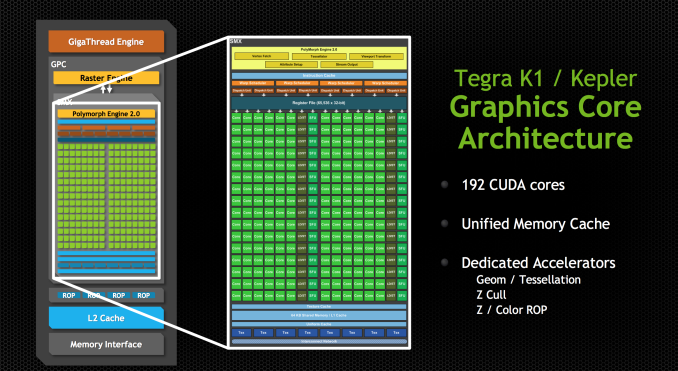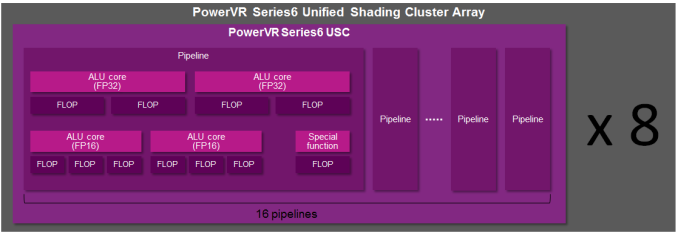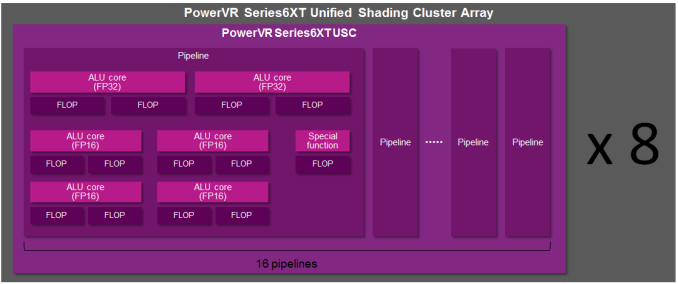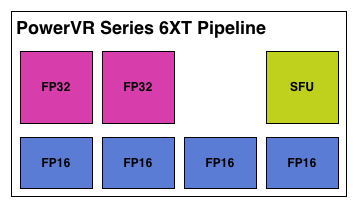Imagination's PowerVR Rogue Architecture Explored
by Ryan Smith on February 24, 2014 3:00 AM EST- Posted in
- GPUs
- Imagination Technologies
- PowerVR
- PowerVR Series6
- SoCs
Imagination’s PowerVR Rogue Series 6/6XT USCs Dissected
Diving right into the heart of the matter, it’s probably best to start with a partial explanation for why Imagination is being so forward about their architecture after all this time.
Imagination’s principle blog, Graphics cores: trying to compare apples to apples, opens up with an argument over just what a “core” is and how it should be counted. Imagination doesn’t name any names, but from the context of their blog it’s clear that they’re worried about being in a core war and losing based on who’s counting cores and how. Time and time again we’ve seen chip and device makers promote their products both by their clockspeeds and their number of cores, leading to both MHz wars and core wars.
Both of these pieces of data are in fact absolutely essential to understanding a product, but consumers – rightfully disinterested in needing a Comp. Engineering degree to understand their purchases – will latch on to one or both numbers, which in turn rewards whoever can push a product with the highest clockspeed or the highest number of cores. The latter in turn can result in some very creative accounting, such as the Motorola X8, where components that aren’t traditionally called a core end up in the core count.
In the SoC GPU space there thankfully isn’t any creative accounting going on, but the nature of the Rogue architecture combined with Imagination’s previous method of counting cores has left Imagination shooting themselves in the foot if they were to get into a core war. If nothing else, the fact that Imagination has previously uses the term “core” to define a single USC, which depending on the specific design may be replicated several times, means that they end up having relatively low core counts.
Compounding that matter is that at a pipeline or shader core level (there’s that word again), Rogue has several FP32 (or FP16) ALUs when other architectures may only have one. So even if one were to count pipelines, Imagination would come up with just 16 cores in a USC.
Their competition and impetus – and again Imagination hasn’t named any names – would appear to be NVIDIA, who just recently announced their Tegra K1 SoCs. A K1 contains 192 CUDA cores, each much narrower than a Rogue pipeline. So even though a high-end Rogue design would have 6 or so USCs, that would only be 96 pipelines versus 192 CUDA cores. Imagination clearly doesn’t want to be dismissed based on this metric, hence their interest in arguing what a core is, and more importantly part of the reason for their desire to open up and discuss their architecture so that we can understand why this difference matters. Imagination may only have 96 pipelines, but they have many more ALUs in each one of those pipelines.
The Rogue
And that brings us to the Rogue architecture. For today’s article and blog releases, Imagination has given us some surprisingly deep details on the Rogue USC, from which we can finally paint a picture of how thread execution works on Rogue, and furthermore gather some idea on what Rogue’s strengths are and what weaknesses it faces.
We’ll begin with differentiating between Rogue as in PowerVR Series 6, and Series 6XT. Series 6XT was the recently announced refresh for the Series 6 family, intending to further improve on PowerVR performance by undertaking several optimizations to the design. At the time of that announcement we didn’t have very many details on what those optimizations were, and now we have a much better idea.
It turns out that Imagination has been doing some tinkering under the hood, and while the number of FP32 slots remains unchanged, the FP16 slots have been altered. Wait, did we say FP16 slots?! Oh yes!
It’s a shame we don’t have such similar low level details for other SoC architectures, but from a PC perspective it’s extremely interesting that Imagination has FP16 slots. As a quick refresher, on the PC side GPUs have been using FP32 operations exclusively for quite some time, and all ALUs have been FP32 for years. But of course mobile trails PC in functionality and shader complexity, so while FP16 usage is rarer in PC games and applications, it can be very common in the mobile space.
The tradeoff of course is performance for accuracy. A 16bit floating point number is pretty imprecise – a 16bit value only gives us 65K combinations – hence it’s rarely used in the PC space in favor of far more accurate 32bit floating point numbers, which offer 4 billion combinations. But a 16bit value is smaller than a 32bit value, requiring less memory to store, less bandwidth to move, less energy to compute, and fewer transistors to operate on. So in the mobile space FP16 is still in use, both on the software side and the hardware side, with developers taking care not to let the lower precision cause rendering errors.
The interesting part on the hardware side is the implementation of dedicated FP16 units, versus just running the values on FP32 units. In the PC space we do the latter, but of course FP16 operations are relatively rare. The catch being that it’s not the most efficient way to execute FP16 operations; we’re firing up a lot of extra transistors and burning extra power to do it. In the PC space this is a reasonable tradeoff, but in the mobile space it’s clear the Imagination has decided otherwise.
The end result being that Rogue has dedicated FP16 units, not unlike how NVIDIA has dedicated FP64 CUDA cores on their desktop architectures. FP16 units take up additional die space – you have to place them alongside your FP32 units – but when you need to compute an FP16 number, you don’t have to fire up a more expensive FP32 unit to do the work. Hence the inclusion of FP16 units is a tradeoff between die size and performance, with the additional performance coming from the reduction in power consumption and heat when operating on FP16 values.
That little segue aside, let’s get back to the difference between Series 6 and Series 6XT. With Series 6, Imagination has an interesting setup where their FP16 ALUs can process up to 3 operations in one cycle.
As a refresher, for a more traditional ALU we say that one ALU can achieve 2 FLOPs in one cycle because we typically count the most dense operation, the Multiply Addition (MAD), otherwise seen as a Multiply Accumulate (MAC) or Fused Multiply Addition (FMA). MAD is a special case where one ALU can do the multiply and the accumulate in one cycle, one of a handful of scenarios where multiple operations can occur at once. MADs and their variants are relatively common in graphics work, hence for GPU performance this is the number we usually quote as it’s especially useful in graphics, and being the bigger number it also makes manufacturers happier, too.
With that said, Imagination’s FP16 ALUs are more intricate than their FP32 ALUs, especially under Series 6. Unfortunately Imagination is unable to share the complete details with us of why this is (as we've noted before, they’re not yet fully open), but it’s clear from this diagram that the Series 6 FP16 ALU has been optimized for some kind of 3 operator instruction. What that operation is we don’t know, but presumably it was important enough for Imagination to give their FP16 ALUs the ability to do it in one cycle.
But from the perspective of an individual pipeline it’s interesting to see that with Series 6XT Imagination has shaken things up by "adding" 2 more FP16 ALUs. Keeping in mind that these are logical diagrams and not physical diagrams – in reality these ALUs are almost certainly tied together in a limited fashion rather than standing alone – Imagination has changed it so that Series 6XT can process more 2 operator FP16 instructions such as MAD. Without more details it’s hard to say for sure what’s going on, but if these “new” FP16 ALUs are really just modifications of the old FP16 ALUs, then it would be a safe assumption that Imagination can still execute their 3 operator instructions over what’s logically 2 ALUs, making these new FP16 ALUs a wider variant of the previous ALU.
Otherwise from this point of view Series 6 and Series 6XT are nearly identical. We have the 2 FP32 ALUs, and then for special functions – transcendentals and the like – a dedicated special function unit exists off to the side. On that note, for the rest of this article we will primarily be focusing on Series 6XT since it’s the newer architecture, but with the exception of FP16 operations it will be equally applicable to both Series 6 and 6XT.















95 Comments
View All Comments
jjj - Monday, February 24, 2014 - link
Far from ideal timing with so many news around, guess i'll have to read it after MWC.rpg1966 - Monday, February 24, 2014 - link
Thank you for sharing.Mondozai - Monday, February 24, 2014 - link
The most important part is what Anand highlighted from this walkthrough; namely that the Rogue series has a chip that is on equal balance if not even stronger than Tegra K1.Poor Nvidia.
Sabresiberian - Monday, February 24, 2014 - link
That remains to be seen - but it does appear to be competitive at this point. We also don't know what the entire Denver+K1 package will do.What kind of surprises me about K1 though is that Maxwell has already been released for the desktop. I would think "M1" (to guess at a name) would be the architecture to build on in the next year.
dragonsqrrl - Monday, February 24, 2014 - link
Uhhh no it doesn't. The article failed to mention this important piece of information, but you realize the 6XT series probably won't come to market before 2015 right? Likely 2H 2015 according to an earlier article published here on Anandtech.grahaman27 - Monday, February 24, 2014 - link
Interesting. Which article mentioned that? Would you mind linking me to it?I can't find an expected release date for this chip anywhere.
dragonsqrrl - Tuesday, February 25, 2014 - link
That's because there is none. It was an estimate given by Ryan Smith based on prior Imagination GPU announcements, and the time it usually takes chipmakers to integrate the design and bring a device to market."Finally, while Imagination doesn’t provide a timeframe for consumer availability (since they only sell designs to chipmakers), based on the amount of time needed to integrate these designs into new products and then get those products in the hands of consumers, we should be looking at a timetable similar to the original Series6 designs. In which case Series6XT equipped SoCs would start appearing in 2015, likely in the latter half."
http://www.anandtech.com/show/7629/imagination-tec...
michael2k - Tuesday, February 25, 2014 - link
Really? You don't think their biggest customer, Apple, which has shown the ability to beat an entire industry to market by almost a year (64 bit ARMv8) and one of the first PVR6 customers to market as well? Anand though it would be 2014 when PVR6 would show up to market, and the A9600 that was supposed to show up in 2013 never did (Apple's A7 did though!)So why do you rule out the real possibility that the Apple A8 would ship with a 6XT this year?
dragonsqrrl - Tuesday, February 25, 2014 - link
I don't know, ask Ryan Smith.My theory for the ~18 month estimate is that it's about how long Apple took to integrate and bring their current series 6 GPU to market in the A7. I suppose if any company had the resources to accelerate that schedule, it would be Apple. But then the question becomes why and does it make sense? There will be faster Series 6 SKU's available for the A8 in the interim.
stingerman - Wednesday, February 26, 2014 - link
But don't forget, Apple has been involved in this design long before Imagination's public reveal. In fact, Apple informed Imaginations design with their real world experience and their own needs. I always expect Apple to get a 6 to 12 month lead. And, Apple has shown themselves to put a very high value on their SoC GPU leadership.